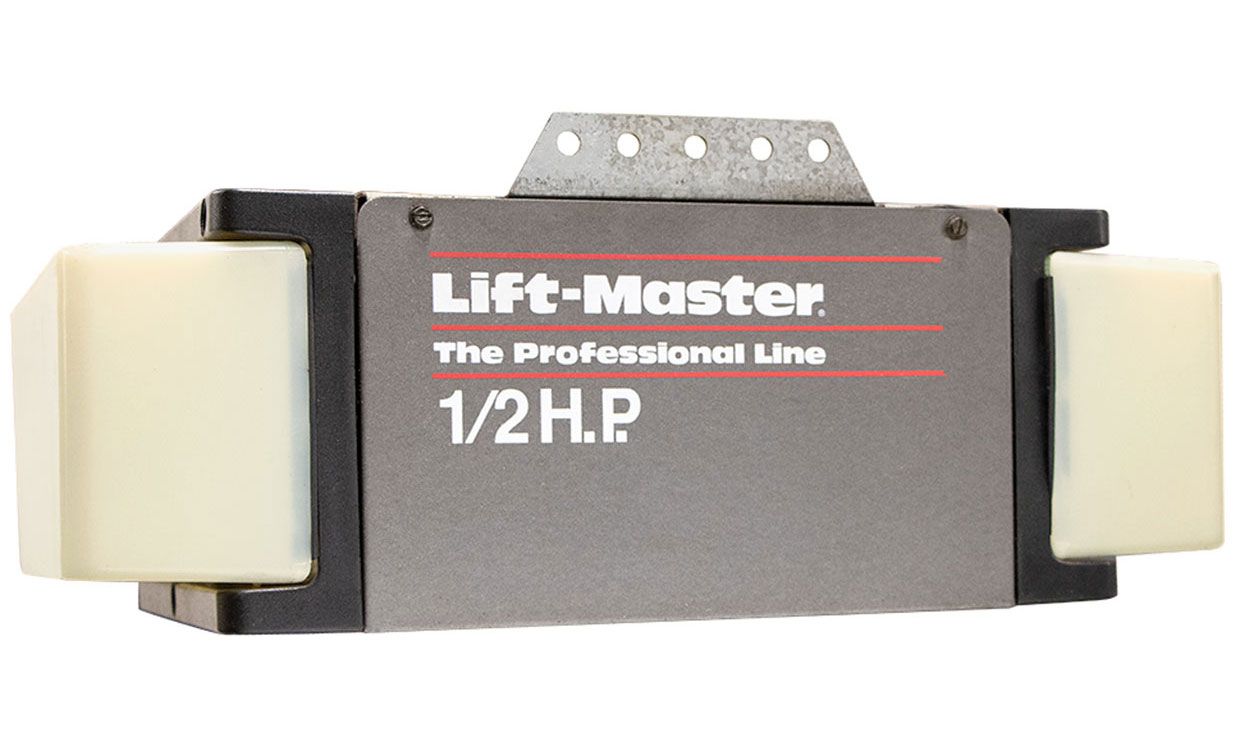The Consumer Electronics Hall of Fame: LiftMaster Garage Door Opener
 Photo: Chamberlain Group Heavy Lifting: The LiftMaster 1260 garage door opener can open sectional or one-piece doors and can be installed with basic hand tools, according to its maker.
Photo: Chamberlain Group Heavy Lifting: The LiftMaster 1260 garage door opener can open sectional or one-piece doors and can be installed with basic hand tools, according to its maker.  Enter Here < Back to Consumer Electronics Hall of Fame
Enter Here < Back to Consumer Electronics Hall of Fame The remote-controlled garage door opener was the first major home automation device. Though invented during the Great Depression in the United States, it wasn't until the 1970s that garage door openers became common in residential use. They almost immediately gained a reputation as a safety hazard, after multiple cases in which young children were struck by descending doors and injured or killed. Not until 1993 did the U.S. government mandate the use of advanced sensors to avert such deaths-a development that paved the way for a single company, LiftMaster, of Oak Brook, Illinois, to dominate the market. Technology originally developed by LiftMaster heavily influenced the development of the standard adopted by the government, and the LiftMaster products compliant with that standard immediately surged in sales.
By then the basic technology was 67 years old. Electric garage door openers were built in 1926 by C.G. Johnson of Hartford City, Indiana, who not coincidentally had invented the segmented overhead garage door four years previously. The first remote-controlled electric garage door openers were built in 1931, by two different teams working independently. In 1954, the Alliance Manufacturing Co., now known as Genie Co., claims to have introduced the first mass-produced, radio-controlled garage door opener. Incidentally, the Overhead Door Co.-which was founded by C.G. Johnson-bought Genie in 1994.
What finally made remote-controlled garage door openers practical for home use in the 1970s was a new approach to mounting garage doors: the split rail, which made it easier to create custom garage doors-important because there were never standards for garage sizes or garage door openings. That innovation opened up opportunities for mass retailers of openers, according to a history of garage door openers published by Genie. Sears, Roebuck and Co., which dominated the do-it-yourself (DIY) market at the time, helped expand the garage door opener market with its decision to resell LiftMaster systems under its renowned Craftsman label.
All along, garage door openers continued to close on people occasionally, particularly children, and pinned them, sometimes fatally. It happened often enough that in 1982, the U.S. government advised that garage door openers should reverse direction if the door struck a solid object. Through the ensuing years, manufacturers devised ways to comply, including the use of force sensors and gauging tension on the chain connecting the motor to the door-opening mechanism.
None of these methods was foolproof, however. Between technology failures and improper installations, garage door openers in the United States from 1982 to 1990 were the cause of countless injuries and 46 deaths, all of them children, according to the U.S. Consumer Product Safety Commission (CPSC).
As early as 1980, engineers had worked out the basics of a system that could prevent such deaths, says Colin Willmott, director of engineering at the Chamberlain Group, which sells garage door openers under four different brand names: LiftMaster, Chamberlain, Merlin, and Grifco. He's been with the company for 57 years. In an interview, Willmott says that he and his development group took note of the infrared technology that was being used in remote controls for television sets and devised an IR sensor system to detect objects in the way of a closing garage door.
 Image: Chamberlain Group Life Saver: Above are the schematics and layouts of the printed circuit boards used in the infrared-based safety system for the LiftMaster garage door opener, introduced in 1993. It was one of the first and most successful models to use IR sensors to prevent the door from closing on and harming children.
Image: Chamberlain Group Life Saver: Above are the schematics and layouts of the printed circuit boards used in the infrared-based safety system for the LiftMaster garage door opener, introduced in 1993. It was one of the first and most successful models to use IR sensors to prevent the door from closing on and harming children. The approach involved mounting an IR emitter a few inches above the ground on either side of the garage door's frame. If the beam was interrupted at any time while the door was closing, the door opener would be stopped and reversed.
The concept was simple, but the installation was a little beyond the abilities of the average home handyman. It required running wires down both sides of the garage door and careful alignment of the sensors, Willmott explains. The company had also tried using an IR unit on one side and a reflector on the other, but that scheme didn't work as well, he says. In 1980 all of that was beside the point, anyway: At that time the technology was too expensive and not really reliable, so it was shelved.
Then in 1988, two children, both from the Minneapolis area, were killed in separate garage door accidents on the same day, Willmott recalls. In response, Minnesota lawmakers decided to create stricter safety requirements for garage door openers. Manufacturers were invited to participate. Willmott volunteered the IR system he had devised years earlier. The technology had improved, and the price had come down significantly. The manufacturers voted eight to four to recommend the IR technology for the Minnesota statutes, Willmott says. It's possible that other manufacturers were amenable to endorsing the use of the IR "electric eye" in part because Willmott had neglected to patent it. Genie, for one, had already "borrowed" the technology, as he wryly puts it.
A few other states, including California, followed Minnesota's lead, and in 1990 Congress passed the Consumer Product Safety Improvement Act, which required that automatic residential garage door operators conform to the latest version of ANSI 325, which recommended the IR sensors. In 1990 the CPSC issued an advisory that IR sensors were commercially available. In 1993, the act was amended to mandate "electric eyes" or the equivalent.
The 1993 version of the LiftMaster garage door opener, complete with the electric eye, was among the first truly safe remote-controlled garage door openers and easily the best-selling one at the time.
 Photo: Chamberlain Group Safety First: In 1992, Colin Willmott [foreground] tests the pioneering safety system, based on infrared sensors, that automatically stopped the LiftMaster garage door opener if an object in the door's path blocked an infrared beam.
Photo: Chamberlain Group Safety First: In 1992, Colin Willmott [foreground] tests the pioneering safety system, based on infrared sensors, that automatically stopped the LiftMaster garage door opener if an object in the door's path blocked an infrared beam. "I guess I was the guy responsible for it becoming a state law in Minnesota, and then a federal law. I've given a few speeches on the subject and, yeah, I tend to get choked up about it," Willmott says. "Between 10 to 50 kids were getting injured or killed a year prior to that," he adds.
The system, still in use today, exploits IR at a wavelength of 930 nanometers, because at that frequency the system very rarely gets fooled by glints of sunlight. The technology is pretty simple. "It's just a photodiode with an amplifier behind it," Willmott says. It has barely changed since he and his team first devised it. LiftMaster originally sourced its IR components from Sharp Electronics. It's now getting its chips from Vishay Intertechnology.
Willmott recalls that the IR components cost about $15 in 1980 and about half that in 1993, when advanced sensors were mandated for garage doors. Nowadays the cost is probably half that again, he says. Semiconductor price reductions have helped Chamberlain keep the prices on its various lines of garage doors steady. In 1980, a garage door opener sold for about $129, Willmott notes, "and you can still buy one for $129."
In 2015, annual global sales of garage door openers exceeded $1 billion for the first time. LiftMaster still dominates the U.S. market. These days, garage door openers are as likely to be installed by home builders as by homeowners. In 2018, 50 percent of home builders reported installing LiftMaster openers, according to Statista. No one else comes close.
Back to Consumer Electronics Hall of Fame >> < Back to Consumer Electronics Hall of Fame